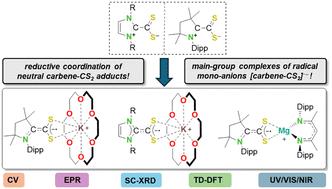当前位置:
X-MOL 学术
›
Chem. Commun.
›
论文详情
Our official English website, www.x-mol.net, welcomes your
feedback! (Note: you will need to create a separate account there.)
Radical anions of 1,1-azoliumdithiocarboxylates
Chemical Communications ( IF 4.3 ) Pub Date : 2024-11-11 , DOI: 10.1039/d4cc05486e M. S. Luff, K. Oppel, I. Krummenacher, H. Braunschweig, U. Radius
Chemical Communications ( IF 4.3 ) Pub Date : 2024-11-11 , DOI: 10.1039/d4cc05486e M. S. Luff, K. Oppel, I. Krummenacher, H. Braunschweig, U. Radius

|
The 1,1-azoliumdithiocarboxylate cAACMe-CS2 (1a) was prepared and its redox chemistry was evaluated and compared to NHC based dithiocarboxylates IDipp-CS2 (1b) and IMes-CS2 (1c). Radical anions [carbene-CS2]˙− were prepared by metallic reduction as the potassium or magnesium ion complexes [K(18-crown-6)(cAACMe-CS2)] (2a), [K(18-crown-6)(NHC-CS2)] (NHC = IDipp: 2b, IMes: 2c), and [Mg(DippNacNac)(cAACMe-CS2)] (3) and extensively characterized (SC-XRD, EPR, UV/VIS/NIR, DFT). These complexes represent the first examples of isolated radical anions of 1,1-dithiolenes.
中文翻译:

1,1-偶氮二硫代羧酸盐的自由基阴离子
制备了 1,1-偶氮二硫代羧酸盐 cAACMe-CS 2 (1a),并评估了其氧化还原化学性质,并与基于 NHC 的二硫代羧酸盐 IDipp-CS2 (1b) 和 IMes-CS2 (1c) 进行了比较。自由基阴离子 [卡宾-CS2] ̇− 通过金属还原制备为钾离子或镁离子络合物 [K(18-冠-6)(cAACMe-CS 2)] (2a)、[K(18-冠-6)(NHC-CS2)] (NHC = IDipp: 2b, IMes: 2c) 和 [Mg(DippNacNac)(cAACMe-CS 2)] (3)和广泛表征(SC-XRD、EPR、UV/VIS/NIR、DFT)。这些复合物代表了 1,1-二硫油烯分离自由基阴离子的第一个例子。
更新日期:2024-11-15
中文翻译:

1,1-偶氮二硫代羧酸盐的自由基阴离子
制备了 1,1-偶氮二硫代羧酸盐 cAACMe-CS 2 (1a),并评估了其氧化还原化学性质,并与基于 NHC 的二硫代羧酸盐 IDipp-CS2 (1b) 和 IMes-CS2 (1c) 进行了比较。自由基阴离子 [卡宾-CS2] ̇− 通过金属还原制备为钾离子或镁离子络合物 [K(18-冠-6)(cAACMe-CS 2)] (2a)、[K(18-冠-6)(NHC-CS2)] (NHC = IDipp: 2b, IMes: 2c) 和 [Mg(DippNacNac)(cAACMe-CS 2)] (3)和广泛表征(SC-XRD、EPR、UV/VIS/NIR、DFT)。这些复合物代表了 1,1-二硫油烯分离自由基阴离子的第一个例子。


















































 京公网安备 11010802027423号
京公网安备 11010802027423号